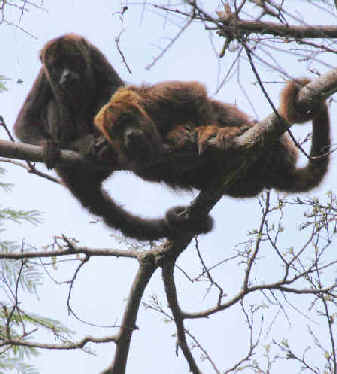
E-mail: font@focusonnature.com
Phone: Toll-free in USA 1-888-721-3555
or 302/529-1876
 |
PO
Box 9021, Wilmington, DE 19809, USA E-mail: font@focusonnature.com Phone: Toll-free in USA 1-888-721-3555 or 302/529-1876 |
THE FOCUS ON NATURE TOUR IN BRAZIL
May 2011
A Rare Bird, a Rare Mammal, & More

The Brown Howler Monkey was 1
of 6 species of monkeys
during our May 2011 tour in Brazil.
Although it is the rarest of the howlers
is was not the rarest of the monkeys during our tour.
The rarest was the Northern Muriqui.
You can read about it in the narrative below.
Links:
List of Birds & Other Wildlife during our Brazil Tour - May 2011
A List
& Photo Gallery of Brazil Birds, in 3 parts:
Part
#1: Tinamous to Doves Part #2: Macaws to Flycatchers
Part #3:
Antshrikes to Grosbeaks
Birds in Minas Gerais Birds in Southeast Brazil
Rare Birds during FONT Tours in Brazil (with some photos)
Mammals & Other Wildlife during FONT Brazil Tours (with some photos)
Upcoming FONT Birding & Nature Tours in Brazil
The following narrative was written by Armas Hill, leader of the tour:
We recently did our 49th FONT
birding & nature tour in Brazil, during the last 2 weeks in
May 2011. It was in
the southeast part of the country, including the more-inland area of Minas
Gerais.
We've not done a Brazil tour previously in May. This one came about as a result
of the earthquake and related problems earlier this year in Japan. We normally,
in recent years, have gone to Japan in May.
During our May 2011 Brazil tour, much of the nature that we observed were birds. We found nearly 300 species.
The rare bird that we found was
the Forbes's Blackbird. Generally, not many people have heard of it.
Partly that is because it only occurs in remote places in eastern Brazil.
And partly it is because as birds go, there's not much notable about it, aside
from its rarity. It's simply all-black, with a slender bill, and a unique voice.
And though not many people have heard of the Forbes Blackbird, even less
have seen it.
Again, there are not many of the blackbirds, with only a population probably of
a few thousand.
That very small population is actually comprised of some very small
subpopulations, spread out in the vast country of Brazil, in isolated places in
the states of Alagoas, Pernambuco, and Minas Gerais.
Again, the bird is mostly in remote places not often visited by birders who
would be apt to recognize one totally black blackbird from another.
The similar Chopi Blackbird is common in much of Brazil. The Epaulet Oriole is widespread in Brazil. Its epaulets in parts of its Brazilian range are rusty, but appear dark, giving the bird an overall black appearance.
We were rather surprised to find
our 3 Forbes's Blackbirds late one afternoon in the top of palm trees in
the valley of a small river, in Minas Gerais, not that far from Serra do Cipo, a
high plateau with some unique flora and fauna, including a rare bird called the
Cipo Canastero, a species that was only described to science as recently as
1985.
We had found the Cipo Canasteo earlier that day, in the morning.
When we saw the Forbes's Blackbirds in the afternoon, their slender bills and distinctive call were both noted. Unfortunately, the birds were not documented by a photograph before they flew from the palm trees, calling as they went.
During the 130 or so years that the species has been known to exist, the Forbes's Blackbird has always had some mysteriousness about it. In fact, it's noted in the literature that even some of the blackbirds that Mr. Forbes found in 1880 were in actually Chopi Blackbirds rather than the Forbes's Blackbirds named after him.
True Forbes's Blackbirds have now been, to date, found at about 20 different places throughout eastern Brazil.
Whereas the Forbes's
Blackbird lack color, many of the nearly 300 species of birds that we saw
had plenty. A number of the tanagers, toucans, trogons and others among
the Neotropical birds were colorful indeed.
Another icterid (a blackbird-type), the Campo Troupial, was with a
brilliant orange coloration.
One of the most brightly colored birds during our tour was the attractive Swallow-tailed Cotinga. With yellow, black, and white nicely patterned in its plumage, this bird, with its long, forked tail, was one of the nicest to see.
Also, notable among the birds
during the FONT May 2011 Brazil Tour, in addition to those already mentioned,
were these:
Black Hawk-Eagle, Black-bellied
Thorntail and Hyacinth Visorbearer (two of the numerous hummingbird
species), Three-toed Jacamar, Robust Woodpecker, Pin-tailed
Manakin, Sharpbill, Red-ruffed Fruitcrow, Streamer-tailed
Tyrant, Black-billed Scythebill, and Black-masked Finch.
Among these birds, the male Pin-tailed
Manakin was truly a favorite, with its colorful plumage of red, black,
white, and green, in addition to its orange eyes.
Other manakins were also seen well and enjoyed during the tour: the Blue
and the White- bearded.
The second of these was one of the first manakins described to science in 1766
by Linnaeus in Sweden, Manacus manacus.
One can't help but wonder what a naturalist in Sweden thought of such colorful
birds brought as specimens from the American tropics.
For us, in Brazil in May 2011, the manakins, along with the many other birds, made Brazil a nice place to be, but the tour was so much more with nice people at interesting places, along with some other notable sightings including in particular that of a very rare mammal, known as the Muriqui.
That rare mammal, with the Tupi
Indian name, is the largest of the monkeys in the New World.
It was the Northern Muriqui that we saw, notable not just for being the
biggest New World monkey, but for being one of the rarest mammals in the world.
The total population of the species is about 500 individuals.
It's been said here that they are large. How large? Well, they measure up to about 5 feet when they hang suspended with their long arms. And these agile monkeys have a long, grasping, prehensile tail that is strong enough to support their entire body weight as they feed or socialize upside down.
Something else can be noted about the Muriquis' anatomy. Due to their diet, which includes leaves in addition to fruits and seeds, they have large intestinal tracts that give both the males and females a "pregnant look". So, while we've heard of "pot-bellied pigs", these, in essence, are "pot-bellied monkeys".
We were so fortunate to see and hear well a group of the Muriquis in a fine section of the Atlantic Forest that has been preserved because, for many years, it has been the home to these monkeys.
In that forest, since the 1980s,
the Muriquis have been studied. From the University of Wisconsin, Karen
Strier came and spent years doing so. In the 1990s, she wrote a book "Faces
in the Forest - The Endangered Muriqui Monkeys of Brazil", in which
she described much of what she learned about the monkeys over the years.
After I returned home from Brazil in May 2011, I read her good book again, and a
couple more things about the Muriquis I'd like to share here with you
now.
They are peaceful creatures,
almost lacking completely the belligerence that primates, especially social
primates, often have.
Muriquis are social,
nearly always in groups, but it is rare for any of them to act aggressively.
During more than 1,200 hours of observation during her first year with the Muriquis,
Karen logged only a very few interactions that could be considered even remotely
aggressive.
The societies of nearly all social primates in the world is based on dominance
relationships. But the Muriquis differ strikingly from that typical
pattern.
The most striking feature of Muriqui society is the tolerance that males
display toward each other even when relating to females in the group.
Also, unlike so many social
primates in the world, Muriquis don't groom one another. But they do
offer friendly reassurances through touch.
They may lightly pat each other on the hand or foot when they pass in a feeding
or resting tree. There's a photo in Karen's book of two wild Muriquis in
a tree giving a handshake signifying a friendly greeting. Imagine two monkeys
shaking hands!
And Muriquis embrace. They have a most impressive full-body embrace , in
which two or more animals walk or swing toward one another and then flip upside
down, so that they are hanging by their tails, face to face, while they wrap
their arms and legs around one another. Such embraces occur in a variety of
contexts.
More about these interesting, peaceful, and rare animals can be read in Karen's
book.
I mentioned that we were
fortunate to see AND HEAR the Muriquis. To me, at the time, they had a
soft vocalization rather like that of a horse.
I read later in "Faces in the Forest" that when the scientists first
went to the forest where we were, they asked the local people where the Muriquis
were, and the locals took them first to the stables. Listening to the horses
whinnying back and forth, they were told to walk in the forest until they
"heard horses".
There are, in all, about a hundred species of monkeys known to be in Brazil. But among them, the Muriqui is special. It has been written that, as a conservation symbol, the Muriqui is for Brazil as the Giant Panda is for China.
Other mammals during our May '11
Brazil Tour included 5 other species of monkeys, all seen well: the Brown
Howler (the rarest of the howlers), Black-tufted Capuchin, Masked
Titi, Buffy-headed Marmoset, and Buffy-tufted Marmoset.
The Brown Howler and the Buffy-headed Marmoset are endangered
species, as are the Muriquis, although not as rare.
Also seen during the tour was another mammal that's nice to see, the Maned
Wolf. We saw it again, as we have during tours in the past, at a monastery
isolated in the hills. As in the past, the Maned Wolf appeared there
after dark.
In addition to the birds
and mammals, there was also a good assortment of butterflies seen
during our May 2011 tour in Brazil. That assortment included nearly 50 species.
But probably most memorable among them were, at one time, over a dozen green Malachites
landing on bright red Poinsettia flowers in bloom in the countryside.
Back to birds:
In this website there's a 3-part complete list & photo gallery of
the Birds of Brazil
With 1,720 species. 1,065 of them during FONT tours. Noting where & when
found.
And with photographs of about 200 species.
Also elsewhere in this website, a list & photo gallery of Brazilian Mammals. With almost 400
species. About 70 during FONT tours.
Both of these lists & photo galleries, and others, are interesting to see.
When I was typing into the list the bats of Brazil, I was intrigued by one of
the names: the Tailed Tailess Bat. Now that's something I'd like to see!
During our May 2011 Brazil Tour, our cumulative bird-list for Minas Gerais was raised to 465 species, with 14 "new for us" during our tours there:Capped Heron, Lesser Yellow-headed Vulture, Violaceous Quail-Dove, Robust Woodpecker, White-wedged Piculet, Black-capped Becard, Rusty-backed Antwren, Palin Xenops, Black-billed Scythebill, Plain-winged Woodcreeper, Masked Gnatcatcher, White-necked Thrush, Forbes's Blackbird, Campo Troupial.
In Southeast Brazil (Rio de Janeiro & Sao Paulo), our cumulative bird-list was raised by 3 to 499 species. No, it's not 500 (yet), but it's a lot of birds!